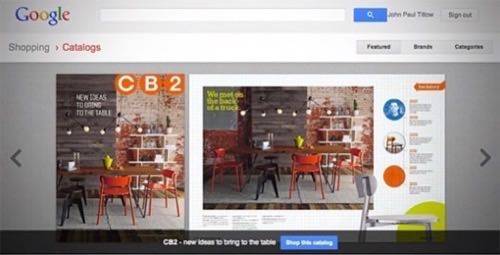
I can hardly be bothered to spend time in an actual, brick-and-mortar store anymore. Some purchases demand it, like produce, jeans and furniture, but I prefer the immediacy and convenience of shopping via the Internet. But there’s a problem: The Web isn’t anything like a store.
Online, we’re expected to know what we’re looking for before we find it. Sure, Amazon supplies recommendations, and Pinterest may evolve into a serendipitous e-commerce experience. But that’s only the beginning of what we need. In some cases, we still need catalogs.
Who wants to deal with a clunky, wasteful paper catalog? Google sure doesn’t. That’s why it launched its own digital alternative last year. Google Catalogs brought page-by-page offerings from familiar brands to the tablet form factor, which turned out to be a perfect fit. On Monday, the company ported that experience to the desktop Web by tacking its interactive catalogs onto Google Shopping.
Google Catalogs takes the familiar print layouts from popular name-brand catalogs – Williams Sonoma, Urban Outfitters, Nike and dozens of others – and adapts them to today’s screens by making each product tappable and easy to purchase. It removes several manual steps from the old, analog way of doing things, while still retaining the age-old familiarity of flipping through a catalog.
Google’s rationale for this push is obvious. While merchants don’t pay to submit their catalog, the service is a starting point for relationships that lead to more data for Google and potentially sponsored shopping listings down the line. And hey, if a vendor hasn’t properly set up an ecommerce operation yet, there’s Google Wallet (formerly Checkout).
Digital Catalogs Make Sense To Consumers
The migration of catalogs to the Web is a win for shoppers as well. It moves a proven product discovery tool from the analog world into digital space where that problem hasn’t been fully solved yet. At the same time, it makes the catalog format far more useful. Like that sweater? Just click on it and buy it. No more dog-earring pages. Plus it’s always good to offer a universally consistent, browser-based experience, since people spend so much time in their tablet browsers and may or may not be aware of the Google Catalogs app for Android or iOS.
And digital catalogs are useful well beyond my digital-native generation. They’re similar enough to their analog counterparts to make sense to just about anyone. My mother, who still loves roaming physical stores and reading newspapers, was delighted when I first handed her my iPad running the Google Catalogs app. She can barely attach a file to an email (love you, Mom!) but, for her, browsing these digital catalogs felt very natural. She was transfixed.
As time passes, it will make less and less sense to print certain things on a large scale. Unfortunately for some legacy media outlets, that reality hasn’t come hitched to a corresponding digital business model. Catalogs are different, in that they’re directly tied to people purchasing things. That’s the whole point. While paper catalogs may be around for years to come, it’s good to see them finding a place in the future.










